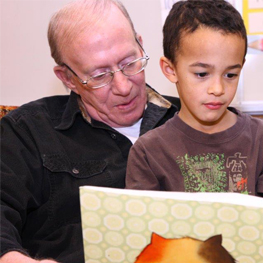
Various factors can cause literacy problems for your child, such as hearing difficulties, lack of exposure to words and language early on in life, and dyslexia, which has to do with the brain wiring a child inherits. The good news is that just about all reading problems can be corrected, especially when identified early on in life. When you, the parent, believe it is possible for your child to learn to read well over time, they, too, will believe in themselves.
There is a wide timespan - usually between the ages of four to seven (or later) - when children are ready to learn to read. This makes it tricky for parents and teachers because pushing a child to start to read too early in life can cause, rather than prevent, reading troubles. And letting a reading problem slide too long, hoping your child will ‘grow out of it,’ may result in behaviors that can become difficult to correct. Ideally, your child should be reading independently by the end of Grade 3. Research suggests that this is an important milestone where children move from ‘learning to read’ to ‘reading to learn.’ If this critical milestone is not met, your child may experience frustration and embarrassment about their reading competency.
But there is help! If your child is struggling to read, here are a few things to keep in mind:
If your child is struggling to read, speak to your child’s teacher as well. They may have more insight about your child’s reading difficulties and can recommend whether or not your child would benefit from one-on-one tutoring.
Calgary Reads innovates and inspires the reading revival, because we all have a role to play in creating a thriving community where children can read with confidence and joy! For videos, resources and games to help build the joy of reading, visit calgaryreads.com.
How to Bolster Your Bookworm
Provided by the Calgary Public Library
Struggling to get your Grade 1 or 2 child to read? Perhaps an award-winning book will help stoke the fire! Snuggle up together on a beautiful Fall evening with one of these reads:
Don’t Throw It to Mo! by David Adler. Easy reader. 2015. Mo Jackson may not be the biggest or strongest, but he loves sports. Even though he’s the youngest kid on his football team, can he help his team win big?
Sidewalk Flowers by JonArno Lawson. Picture book. 2015. A little girl collects wildflowers, unnoticed by her distracted father. This wordless picture book is an ode to the importance of small things.
Hi, Koo! by Jon Muth. Picture book. 2014. Explore the four seasons through charming and delightful haiku.
Queen Victoria’s Bathing Machine by Gloria Whelan. Picture book. 2014. Queen Victoria loves to swim, but how can she get in the water without her devoted subjects glimpsing her swimming suit? Prince Albert may have a quirky solution.
The Watermelon Seed by Greg Pizzoli. Picture book. 2013. This silly crocodile has one fear: watermelon seeds. What will he do when he accidentally swallows one? Crocodile lets his imagination run wild with the possibilities.
Extra Yarn by Mac Barnett. Picture book. 2012. A story about how a girl and her box of magical yarn change a community.
One Cool Friend by Toni Buzzeo. Picture book. 2012. Elliot asks his father for a penguin during a visit to an aquarium. So begins this tale of friendship and mischief between boy and penguin.
Virginia Wolf by Kyo Maclear. Picture book. 2012. Virginia is in a wolfish mood; can Vanessa cheer her up with a painting? Based loosely on the relationship between author Virginia Woolf and her sister.
Grandpa Green by Lane Smith. Picture book. 2011. Grandpa Green was a farm boy, a soldier, and an artist. Explore Grandpa Green’s garden, a magical world shaped by memories and imagination.
We Are in a Book by Mo Willems. Easy reader. 2010. Join the lovable Elephant and Piggie as they learn how fun it is to be in a book while it is to read. The reader is part of the humor in this witty tale.
To learn about all of the fantastic books and programs offered at your local library, visit calgarylibrary.ca.
Calgary’s Child Magazine © 2024 Calgary’s Child